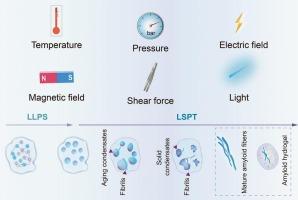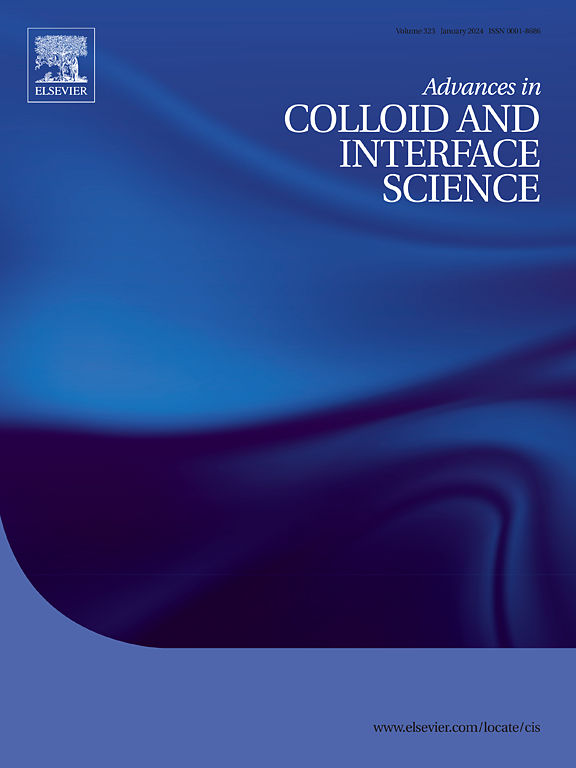解码物理环境在蛋白质相变中的作用
IF 19.3
1区 化学
Q1 CHEMISTRY, PHYSICAL
引用次数: 0
摘要
相变作为物理科学中的基本现象,已经得到了很好的研究,并建立了一个完整的理论框架。近年来,随着液-液相分离(LLPS)的里程碑式发现,其研究已扩展到生物科学领域,最新的研究重点不仅限于LLPS,还包括液-固相转变(LSPT)。这些相变是重要的基本生物学过程,如无膜细胞器的形成,以及神经退行性疾病、2型糖尿病和淀粉样变性疾病等疾病的发病机制。这些发现为解读生命系统的物理化学原理和相关的疾病发病机制提供了前所未有的视角。在这篇综述中,我们系统地分析了相变途径的层次进展,描绘了物理因素(如温度,磁场,电场等)如何控制转变动力学和最终状态选择。方法学部分提供了适用于研究生物系统相变的实验技术的全面回顾。生物学相变的阐明是至关重要的,因为它不仅为理解细胞组织的时空调节提供了新的范式,而且为开发针对病理相变的治疗策略提供了机制见解。值得注意的是,物理调节机制的识别可以帮助开发非药物干预策略,通过精确控制的相位操作,有可能彻底改变蛋白质错误折叠疾病的治疗方法。本文章由计算机程序翻译,如有差异,请以英文原文为准。

Decoding physical environment's role in protein phase transition
Phase transitions, as fundamental phenomena in physical sciences, are well-studied and a full theoretical framework has been established. The research has recently expanded into biological sciences after the milestone discovery of liquid-liquid phase separation (LLPS), and the latest studies are focusing not only LLPS but also liquid-solid phase transition (LSPT). These phase transitions are important fundamental biological processes such as formation of membraneless organelles, and pathogenesis of diseases such as neurodegenerative diseases, type 2 diabetes, and amyloidogenic disorders. These findings provide unprecedented perspectives for deciphering the physicochemical principles underlying living systems and associated disease pathogenesis. In this review we systematically analyze the hierarchical progression of phase transition pathways, delineating how physical factors (e.g., temperature, magnetic field, electric field, etc.) govern transition kinetics and final state selection. The methodological section provides a comprehensive review of experimental techniques applicable in studying phase transitions in biological systems. The elucidation of biological phase transitions is fundamentally important in that it not only provides a novel paradigm for understanding spatiotemporal regulation of cellular organization, but also provides mechanistic insights for developing therapeutic strategies targeting pathological phase transitions. Notably, the identification of physical modulation mechanisms can help to develop non-pharmacological intervention strategies, potentially revolutionizing treatment approaches for protein-misfolding disorders through precisely controlled phase manipulation.
求助全文
通过发布文献求助,成功后即可免费获取论文全文。
去求助
来源期刊
CiteScore
28.50
自引率
2.60%
发文量
175
审稿时长
31 days
期刊介绍:
"Advances in Colloid and Interface Science" is an international journal that focuses on experimental and theoretical developments in interfacial and colloidal phenomena. The journal covers a wide range of disciplines including biology, chemistry, physics, and technology.
The journal accepts review articles on any topic within the scope of colloid and interface science. These articles should provide an in-depth analysis of the subject matter, offering a critical review of the current state of the field. The author's informed opinion on the topic should also be included. The manuscript should compare and contrast ideas found in the reviewed literature and address the limitations of these ideas.
Typically, the articles published in this journal are written by recognized experts in the field.

 求助内容:
求助内容: 应助结果提醒方式:
应助结果提醒方式:


